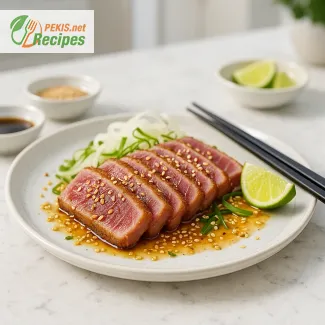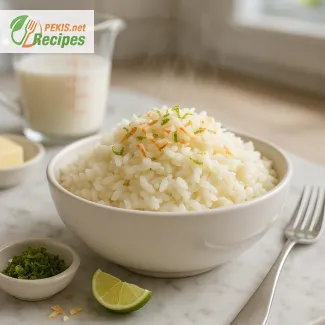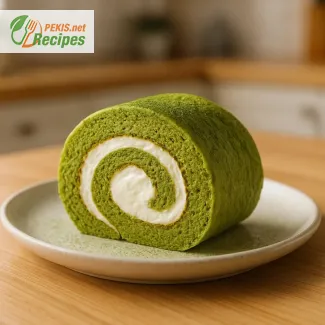Perfect Tuna Tataki serves 4 portions and comes together in just 15 minutes of prep and 5 minutes of cooking. The sashimi-grade tuna is briefly seared for a crisp sesame crust while staying tender and ruby inside, then finished with soy sauce, lime, and ponzu for a bright umami balance. Light yet satisfying, it’s ideal for elegant dinners or quick gourmet meals. Best enjoyed fresh, though it can be prepared a few hours ahead and chilled before slicing for effortless serving.

Exquisite Seared Tuna Tataki with Japanese Flavors
The perfect harmony of sesame, soy, and tender tuna
Slicing through the lightly seared surface of fresh tuna, you reveal a vibrant ruby center that captures both the elegance and simplicity of Japanese cuisine. Each bite of Tuna Tataki offers a delicate balance — crisp sesame crust, silky fish texture, and the deep umami of soy and citrus. It’s the kind of dish that feels both luxurious and effortless, perfect for impressing guests or savoring a quiet dinner that celebrates purity of flavor.
The secret lies in contrast — the brief kiss of heat that sears the exterior while leaving the core raw and cool. This interplay of temperatures and textures defines Tataki, a Japanese culinary method that originated from Kochi Prefecture. Legend credits the samurai Sakamoto Ryōma with introducing this technique in the 19th century after being inspired by Western searing methods. Since then, Tuna Tataki has evolved from humble beginnings into a refined dish served in fine dining restaurants across the world, known for its minimalism, freshness, and balance.
The key components work together in quiet precision. Tuna loin or fillet, ideally sashimi-grade, provides a firm texture that holds up under quick searing. A soy-based marinade adds umami depth, while rice vinegar and yuzu or lime juice offer acidity that lifts the richness of the fish. Sesame seeds, toasted to a light golden hue, bring nutty warmth and a gentle crunch. Some versions enhance the experience with ginger, garlic, or ponzu sauce, accentuating the Japanese character of the dish.
Cooking Tataki isn’t about applying heat — it’s about restraint. The pan must be blistering hot, but the searing lasts only seconds per side. Once done, the fish rests briefly, then cools to room temperature before being sliced thinly against the grain. The slices, tender yet structured, are often served with daikon radish, scallions, or a drizzle of citrus soy dressing. Presentation plays a vital role: arranged neatly, garnished with microgreens or sesame, and often accompanied by a small dipping bowl for the sauce.
Why you’ll love this Tuna Tataki
- Fast yet elegant – from preparation to plating in under 20 minutes.
- Rich in flavor – every bite blends sesame, soy, and citrus in perfect harmony.
- Visually stunning – vibrant contrast between the seared edge and raw core.
- Healthy indulgence – light, protein-rich, and refreshing.
- Restaurant-quality at home – simple steps deliver a gourmet finish.
Ingredients that make the difference
Each element of this dish has a purpose beyond taste:
- Tuna brings purity and clean ocean flavor; freshness determines success.
- Soy sauce adds the deep umami base that defines Japanese cooking.
- Sesame oil and seeds lend warmth and aromatic intensity.
- Citrus — whether yuzu, lime, or lemon — brightens and balances the richness.
- Ginger and garlic contribute a lively, spicy undertone.
- Green onions add a crisp, peppery freshness that completes the bite.
When these flavors come together, the result is a dish that feels light yet deeply satisfying — a true celebration of minimalism and precision.
Storing and preparing ahead
Tuna Tataki is best served immediately after searing, but it can be prepared slightly in advance if handled properly. After searing, wrap the tuna tightly in plastic wrap and refrigerate for up to 4 hours. Slice just before serving to maintain the texture and freshness. Leftovers should be enjoyed the same day — raw fish doesn’t benefit from storage beyond that window.
Culinary context: Tataki as an expression of balance
In Japanese gastronomy, Tataki isn’t just a technique — it’s a philosophy. The brief sear represents discipline and respect for the ingredient, keeping the essence intact rather than overpowered by heat. The accompanying sauce mirrors this balance, combining salty soy, bright citrus, and subtle sweetness. The experience is multi-sensory: aroma of toasted sesame, the sound of searing, the visual allure of crimson tuna, and the clean, oceanic taste that lingers long after the last bite.
Creative variations
While traditional Tuna Tataki keeps close to its roots, modern interpretations have expanded the possibilities:
- Spicy Tataki – add a light drizzle of chili oil or wasabi mayo for a kick.
- Citrus Tataki – replace soy sauce with ponzu and top with orange zest.
- Fusion Tataki – pair with avocado slices and sprinkle with crispy shallots.
- Smoked Tataki – lightly smoke the seared tuna for a bold, umami depth.
- Tataki salad – serve over mixed greens with a sesame dressing for a lighter meal.
Essential tips for mastering seared tuna
- Always use sashimi-grade tuna — freshness is non-negotiable.
- Pat the fish dry before searing to ensure an even crust.
- Use a cast-iron or carbon-steel pan for the best sear.
- Don’t overcook — 20–30 seconds per side is enough.
- Rest before slicing to prevent the juices from escaping.
When done correctly, Tuna Tataki embodies what makes Japanese cooking exceptional — precision, respect for ingredients, and the pursuit of balance between simplicity and sophistication.
Years of working with fresh seafood have taught the importance of precision — the exact heat, timing, and balance that define a flawless Tuna Tataki. Each sear and slice carries the memory of countless test plates, all chasing that delicate contrast between crisp sesame crust and silky raw center. Attention to texture, aroma, and presentation makes this dish not just a recipe, but a moment of refined simplicity.
PEKIS – professional chef and recipe developer with over 25 years of experience in cooking and baking, specialized in European and international cuisine.
- Prepare the tuna: Pat the tuna dry with paper towels to remove moisture. This ensures an even sear and prevents splattering.
- Marinate: In a small bowl, whisk together soy sauce, rice vinegar, sesame oil, lime juice, grated ginger, and minced garlic. Place the tuna loin in a shallow dish and pour the marinade over it. Turn to coat evenly and let sit for 10 minutes at room temperature.
- Coat with sesame: Spread the black and white sesame seeds evenly on a plate. Lift the tuna from the marinade and roll it in the seeds until the entire surface is coated. Press gently to help the seeds adhere.
- Sear: Heat vegetable oil in a heavy-bottomed skillet or cast-iron pan over high heat. When the oil begins to shimmer, place the tuna in the pan. Sear each side for about 20–30 seconds, just enough to create a golden crust while keeping the center raw. Avoid overcooking.
- Rest and slice: Remove the tuna from the pan and let it rest for 2–3 minutes. Using a sharp knife, slice it thinly against the grain into 0.5 cm (0.2 inch) slices.
- Serve: Arrange the tuna slices neatly on a chilled plate. Garnish with sliced scallions and grated daikon. Drizzle with ponzu sauce or serve it on the side for dipping.
Serving suggestion: Serve immediately as an appetizer or light main course. Complements well with steamed jasmine rice, wakame salad, or avocado slices.
FAQ questionWhat tuna cut works best for Tuna Tataki?
Use a center-cut, sashimi-grade tuna loin (firm, evenly thick, minimal sinew). Its dense structure withstands a high-heat sear while keeping a ruby-raw core. Avoid tail pieces or uneven fillets; inconsistent thickness leads to overcooked edges and cold centers that slice poorly.
FAQ questionHow do I get the sesame crust to stick and stay crisp?
Pat the tuna bone-dry first. Lightly marinate (short time, not soaking), then roll in a 50/50 mix of black and white sesame seeds, pressing to adhere. Sear in a smoking-hot pan with a thin film of neutral oil, 20–30 seconds per side, and don’t move the fish while searing. The combo of dry surface + high heat creates a toasty, crackly crust that doesn’t fall off.
FAQ questionWhat’s the ideal doneness and slicing technique?
Aim for deep sear outside, cool rare center. After searing, rest 2–3 minutes so juices settle, then slice against the grain into 0.5 cm (0.2 inch) slices with a long, sharp knife in single strokes. This preserves a clean edge, prevents tearing, and keeps the contrast of textures intact.
FAQ questionWhich sauces pair best—and how salty should it be?
Classic options are light soy + citrus (yuzu, lime) or ponzu. Keep salinity balanced, not dominant: let umami + acidity lift the fish while sesame aroma leads. For complexity, add fresh ginger or a drop of sesame oil. Finish with scallions and grated daikon to refresh the palate between bites.
FAQ questionCan I make it gluten-free or allergen-friendly?
Yes. Swap soy sauce for tamari (gluten-free) and confirm ponzu is GF or make your own (tamari + citrus + rice vinegar). If avoiding sesame, replace seeds with crushed flax or chia for a nutty, crunchy crust. Always verify labels—hidden gluten often appears in bottled sauces.
FAQ questionHow far in advance can I prepare Tuna Tataki?
Sear the tuna up to 4 hours ahead. Wrap tightly and refrigerate whole; slice just before serving to maintain a silky interior and crisp exterior. Leftovers are best the same day; prolonged storage dulls aroma, texture, and color.
Perfectly seared Tuna Tataki brings together the essence of minimalism and mastery. Each slice embodies balance — the fine line between raw delicacy and toasted sesame intensity. With just a few quality ingredients and a precise sear, this dish transforms into a culinary experience that celebrates purity, control, and contrast.
There’s something deeply satisfying about the harmony of soy, citrus, and sesame, wrapping around the gentle flavor of fresh tuna. The textures dance between crisp and tender, while the aroma of lightly toasted seeds lingers with every bite. It’s a dish that feels both elevated and effortless, perfect for moments when simplicity becomes sophistication.
Tuna Tataki also reflects the art of mindful preparation — each movement deliberate, each second at the pan decisive. In mastering it, you learn not just a technique, but a rhythm: quick, confident, and purposeful. The result is a plate that commands attention through elegance rather than complexity.
Whether served as a refined appetizer or the star of an elegant dinner, this seared tuna remains timeless. Its lightness invites versatility; its balance inspires calm. Every element — from the sesame crust to the glistening interior — reminds us that great cooking often begins not with excess, but with precision, restraint, and respect for the ingredient.
Allergens present in this recipe:
- Fish (tuna)
- Soy (soy sauce, ponzu)
- Sesame
Gluten: Contains gluten (from soy sauce and ponzu).
Tips to make it allergen- and gluten-free:
- Replace soy sauce with tamari or gluten-free soy sauce.
- Substitute sesame seeds with crushed flaxseeds or chia seeds for a nut-free crust.
- Ensure ponzu sauce is gluten-free or make your own using tamari, citrus juice, and rice vinegar.
- Vitamin B12: 4 µg – supports red blood cell formation and neurological health.
- Vitamin D: 2 µg – essential for bone health and immune support.
- Vitamin B6: 0.8 mg – aids in protein metabolism and energy production.
- Selenium: 45 µg – powerful antioxidant that protects cells from damage.
- Phosphorus: 250 mg – supports strong bones and teeth.
- Magnesium: 40 mg – contributes to muscle and nerve function.
- Potassium: 420 mg – helps regulate blood pressure and fluid balance.
- Sesamin and sesamolin (from sesame seeds): 20 mg – support liver function and reduce oxidative stress.
- Gingerol (from ginger): 8 mg – has anti-inflammatory and digestive benefits.
- Isoflavones (from soy sauce): 5 mg – may support heart health and hormone balance.
- Vitamin C (from lime juice): 10 mg – strengthens the immune system and enhances iron absorption.





